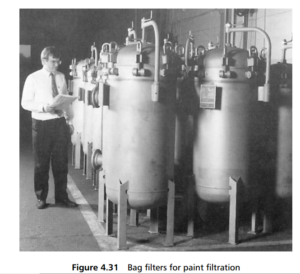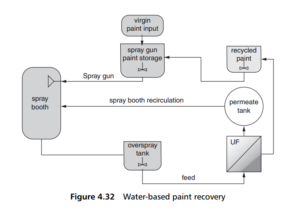0
-
An empty cart
You have no item in your shopping cart
Process filtration in the manufacture of paints and inks includes the treatment of adhesives, resins, and process and wastewater, as well as paints, varnishes, inks and other coatings. Bag filters ( Figure 4.31) and bonded media filters are often used for highviscosity applications such as the removal of oversize particles from paints and inks.

Cathodic electrocoating is employed extensively in the automotive industry, where basically three filtration systems are commonly used:
● ultrafiltration for separating suspended solids, colloids and high molecular weight materials in solution
● strainers for separating large diameter suspended solids, and
● bag filters made from meltblown polypropylene for separating suspended solids between 1 and 800um.
Rigid depth filter cartridges retain deformable or soft agglomerates of oils, gels, fluoro-carbons and silicones. These are among the most difficult contaminants to remove from a coatings application. The deformables are retained by coalescence,
surface tension and adsorption. Other contaminants such as large, rigid particles or small agglomerates of particles can be removed by absolute-rated filters with good classification characteristics.
Non-rigid filters such as bags and meltblown cartridges compress and relax with pulsating pumps, or pumps that are cycled on and off. These pulsations can affect the pore size of the medium and alter removal efficiencies. Non-rigid filters, such
as yarn-wound and some meltblown cartridges, may exhibit unloading of contaminants once a critical differential pressure is reached. Rigid filters typically maintain the desired filter pore size regardless of the differential pressure. Surface filters
such as bags and vibrating screens are more likely to release fibres and deformables than are depth filters.
Bag filtration used in electrocoating of metal parts has proved successful for a number of reasons. These include:
● low investment cost
● low replacement cost
● high dirt-holding capacity
● ability to filter at high volumetric flow rates, and
● up to 99% filtration at a given micrometre rating.
Spiral-wound membrane modules, with hydrophilic membranes, are suited for water-based paint recovery in spray paint installations, and also for electrocoat paint filtration. Figure 4.32 shows a schematic for an ultrafiltration system for treating spray booth waste.

Ceramic microfiltration is another technology that is being applied in solvent and water-based paint production, and paint applying, industries for the treatment of paint-water mixtures, plus other areas such as oil-water emulsions, compressor
condensate and degreasing baths.